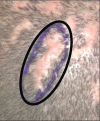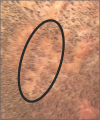RADIATION THERAPY for the Adjunctive Treatment of Surgically Excised Keloids: A Review
- PMID: 28979658
- PMCID: PMC5605209
RADIATION THERAPY for the Adjunctive Treatment of Surgically Excised Keloids: A Review
Abstract
BACKGROUND: Radiotherapy has been used historically to treat a wide variety of dermatologie conditions, including nonmelanoma skin cancers, lymphomas, and inflammatory skin conditions. Recently, radiotherapy has been used increasingly as a valuable tool in the postsurgical treatment of large or recalcitrant keloids. OBJECTIVE: The objective of this review was to explore the use of radiation therapy as an adjuvant to surgically excised keloids. DESIGN: A PubMed search of all published English literature regarding the applications of radiotherapy for the treatment of keloids was performed using a combination of keywords including radiation, radiotherapy, brachytherapy, electron beam, superficial radiation, orthovoltage radiation, and keloid. The results were analyzed and collated. RESULTS: A comprehensive review of radiotherapy for the adjuvant treatment of keloids was outlined. CONCLUSION: Radiotherapy appears useful as an adjuvant therapy to surgically excised keloids. Dermatologists should be well versed in radiotherapy to provide optimal care for patients with recalcitrant keloids.
Keywords: Radiotherapy; brachytherapy; electron beam; keloid; orthovoltage radiation; superficial radiation.
Conflict of interest statement
FUNDING:No funding was provided for this study. DISCLOSURES:Dr. Cognetta was an early advisor on the medical advisory board for Topex (now known as Sensus Healthcare) during the sale of the company, and organized an advisory board composed of a dermatologist, radiation oncologist, and medical physicist. He was given a stock option for his advisory role during the company’s formative stages in 2012. Drs. Cheraghi and Goldberg have no conflicts of interest relevant to the content of this article.
Figures
Similar articles
-
Surgical Excision and Adjuvant Brachytherapy vs External Beam Radiation for the Effective Treatment of Keloids: 10-Year Institutional Retrospective Analysis.Aesthet Surg J. 2017 Feb;37(2):212-225. doi: 10.1093/asj/sjw124. Epub 2016 Aug 23. Aesthet Surg J. 2017. PMID: 27553611
-
Consensus Guidelines on the Use of Superficial Radiation Therapy for Treating Nonmelanoma Skin Cancers and Keloids.J Clin Aesthet Dermatol. 2019 Feb;12(2):12-18. Epub 2019 Feb 1. J Clin Aesthet Dermatol. 2019. PMID: 30881578 Free PMC article.
-
Adjuvant Radiotherapy for Keloids.Aesthetic Plast Surg. 2022 Feb;46(1):489-499. doi: 10.1007/s00266-021-02442-w. Epub 2021 Aug 20. Aesthetic Plast Surg. 2022. PMID: 34415398 Review.
-
Current advances in the selection of adjuvant radiotherapy regimens for keloid.Front Med (Lausanne). 2022 Nov 8;9:1043840. doi: 10.3389/fmed.2022.1043840. eCollection 2022. Front Med (Lausanne). 2022. PMID: 36425105 Free PMC article. Review.
-
Keloids treated with excision followed by radiation therapy.J Am Acad Dermatol. 1994 Aug;31(2 Pt 1):225-31. doi: 10.1016/s0190-9622(94)70152-0. J Am Acad Dermatol. 1994. PMID: 8040405
Cited by
-
Keloids: Current and emerging therapies.Scars Burn Heal. 2020 Aug 10;6:2059513120940499. doi: 10.1177/2059513120940499. eCollection 2020 Jan-Dec. Scars Burn Heal. 2020. PMID: 32844039 Free PMC article. Review.
-
Airway Edema after Keloid Resection and Superficial Radiation: Unexpected Event in an Unusual Location.Plast Reconstr Surg Glob Open. 2023 Feb 17;11(2):e4823. doi: 10.1097/GOX.0000000000004823. eCollection 2023 Feb. Plast Reconstr Surg Glob Open. 2023. PMID: 36817279 Free PMC article.
-
Surface brachytherapy in the treatment of keloid scars in Mexico.Rep Pract Oncol Radiother. 2020 Jan-Feb;25(1):133-138. doi: 10.1016/j.rpor.2019.11.002. Epub 2019 Dec 24. Rep Pract Oncol Radiother. 2020. PMID: 31920465 Free PMC article.
-
Efficacy of Surgical Excision and Adjuvant High-dose Rate Brachytherapy in Treatment of Keloid: Our Experience.J Cutan Aesthet Surg. 2021 Jul-Sep;14(3):337-343. doi: 10.4103/JCAS.JCAS_120_16. J Cutan Aesthet Surg. 2021. PMID: 34908777 Free PMC article.
-
The outcome of postoperative radiation therapy following plastic surgical resection of recurrent ear keloid: a single institution experience.J Egypt Natl Canc Inst. 2022 Jan 24;34(1):4. doi: 10.1186/s43046-022-00105-8. J Egypt Natl Canc Inst. 2022. PMID: 35067821
References
-
- Gold MH, Berman B, Clementoni MT, et al. Updated international clinical recommendations on scar management: part 1--evaluating the evidence. Dermatol Surg. 2014;40:817–824. - PubMed
-
- Mustoe TA, Cooter RD, Gold MH, et al. International clinical recommendations on scar management. Plast Reconstr Surg. 2002;110:560–571. - PubMed
-
- Luo S, Benathan M, Raffoul W, et al. Abnormal balance between proliferation and apoptotic cell death in fibroblasts derived from keloid lesions. Plast Reconstr Surg. 2001;107:87–96. - PubMed
-
- Lee KS, Jung JB, Ro YJ, et al. Effects of x-irradiation on survival and extracellular matrix gene expression of cultured keloid fibroblasts. J Dermatol Sci. 1994;8:33–37. - PubMed
-
- Ji J, Tian Y, Zhu YQ, et al. Ionizing irradiation inhibits keloid fibroblast cell proliferation and induces premature cellular senescence. J Dermatol. 2015;42:56–63. - PubMed
Publication types
LinkOut - more resources
Full Text Sources


